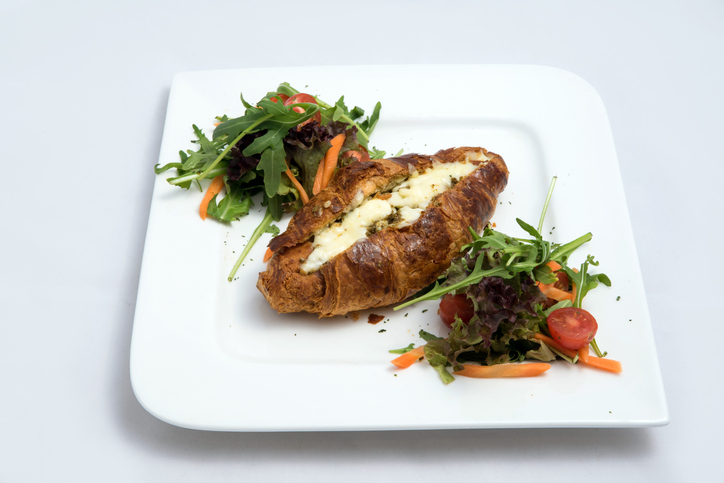This croissant recipe uses vegetable oil, which helps obtain a lighter version with a reduced saturated fat content. Also, using whole grain flour increases the nutrient value (more vitamins, especially of the B complex) and fibre content. The rocket complements the salmon and cream making it peppery to taste.
Serves: 16 servings
Dietary: Use soy soft cheese if lactose intolerant
Preparation time: 5 1/2 hours
Cooking time: 20 minutes
Ingredients
500 g whole grain flour
100 g sugar
250 ml soy milk
120 g light vegetable oil
5 g active dry yeast
1/2 teaspoon salt
Filling for two croissants
1/2 medium avocado, mashed
1/2 tsp lemon juice
grated lemon rind, pinch
Cayenne pepper, pinch
Salt, pinch
40 g Feta cheese, reduced/low fat, crumbled
1 medium tomato, cut into slices
Method
- In a large bowl, mix together the dry ingredients.
- In another bowl mix together the liquid ones.
- Combine the ingredients by adding the liquid ingredients to the dry ingredients.
- Work the dough for around 20 minutes until it is elastic.
- Let the dough sit at room temperature for around 3 hours until the volume has doubled.
- Divide the dough into two parts.
- Use some flour to roll the dough into a thin layer.
- Cut the rolled dough into slices as it was a pizza.
- Roll each slice to obtain a typical form (start from the larger side).
- Brush the croissant with some soy milk and let it sit for around 30 minutes to 2 hours.
- Bake at 175°C for 20 minutes.
- Remove from oven and cool.
- Meanwhile, mash the avocado in a bowl and add the lemon juice, cayenne pepper and salt.
- Stuff the croissant with mashed avocado and feta.
- Decorate the stuff with tomato slices.
This recipe has been donated by Francesca Straniero and Nourhan Barakat Registered Associate Nutritionists
Nutrition Information
Per filled croissant:
Total calories: 317 kcal
Fat: 18.0 g
Saturated Fat: 3.6 g
Carbohydrate: 27.0 g
Total sugar: 8.8 g
Fibre: 4.6 g
Protein: 10.0 g
Salt: 0.87 g
Nutrition Facts
This wholegrain croissant recipe has higher fibre content and reduced saturated fat content than the traditional croissant. The filling increases the nutrient content, making it a good source of omega-3 fatty acids, protein (increasing its satiety value), fibre, vitamin E, and B vitamins (riboflavin, niacin and folate).
© 2021 The Caroline Walker Trust

